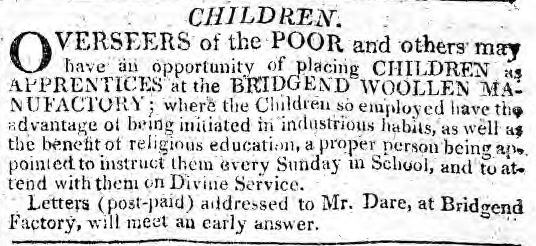 |
| An Illustration of Bridgend.
"Bridgend's first effort in the industrial revolution was a heavy disaster"
|
The first impact of the industrial revolution upon Bridgend was the establishment and failure of a large woollen factory. Woollen manufacture had long been established in Glamorgan as in other parts of Wales, but it was essentially of the domestic or family type and a large factory was a new thing.
The Glamorgan Agricultural Society had been formed on the 28th of October, 1772. The primary goal of the society was to improvement of agriculture but it did embark upon other matters. The society assisted a Fishery Society at Swansea and gave support to the manufacture of textiles.
In 1790 the society purchased a Spinning Jenny and procured a person:
"To instruct hose engaged in flannel and hose manufacture, in the hope that it may tend to the introduction of manufacturies, and thus prevent the exportation of raw wool from the County."
It is known that it was set up at Bridgend and working in 1791, but there are no further mention of the Spinning Jenny in the records of the society. The society was thought to have aided the improvement of domestic industry in the area. John Franklen and Thomas Wyndham M.P of Glamorgan, were the two chief member of the Company Proprietors by whom the factory was erected. The date of the erection of the woollen mill is unknown but it was clearing in full operation during 1801.
It was a large building for the time, three storeys and situation a short distance to the north of the Old Stone Bridge. The power was supplied by a water wheel at the eastern end of the building. There was already a weir at Cwm Bridge which supplied the water to the manorial corn mill at Newcastle. It was extended to carry the water from the mill to the factory, and the water debouched into the river immediately above the bridge.
The mill frequently advertised for children aged between 10 and 14 years old to become apprentices.
The advertisements emphasised that the children who were employed would have the advantage of being trained in industrial habits, religious education, would attend Sunday School and Divine Service.
 |
| 17th October, 1807. |
 |
| 22nd of October, 1808. |
The last meeting was held at Cowbridge in 1820 'to transact business of the greatest importance'. The
buildings were sold to a Tanning business, who obviously converted the buildings into a tanyard. Like the Woollen Mill before it, the business only lasted a few years.
We know this as in 1829, the tanyard was auctioned and was converted into a brewery, owned by the Stiles family.
For a long period, the brewery was a very successful and was well known throughout the county. During the start of the 20th century, the brewery was given up and supplies were purchased and the building became a warehouse.
In 1941, the building was purchased by H. and G. Simonds LTD, they demolished the old building and erected a modern warehouse on the site of the previous one.
 |
| Stiles Brewery, 1915. |
(Sources: Dr. Randall - LLGC - Cambrian)
No comments
Post a Comment
Note: only a member of this blog may post a comment.